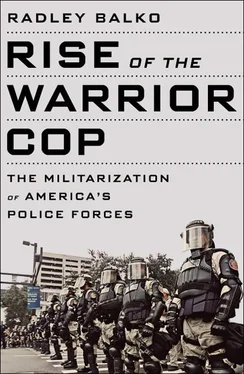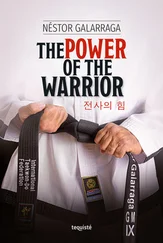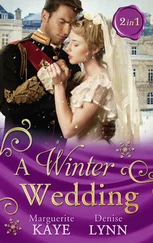THERE ARE TWO FORMS OF POLICE MILITARIZATION: DIRECT and indirect. Direct militarization is the use of the standing military for domestic policing. Indirect militarization happens when police agencies and police officers take on more and more characteristics of an army. Most of this book will focus on the latter form of police militarization, which began in the United States in the late 1960s, then accelerated in the 1980s. But the two forms of militarization are related, and they have become increasingly intertwined over the last thirty years. So it’s worth looking briefly at direct militarization in the twentieth century as well.
As discussed in the previous chapter, direct militarization has a longer history in the United States but has been more limited in scope. One reason may be that deploying military forces domestically usually requires a formal declaration by the president, which means such deployments have been limited to self-contained events. By the middle of the twentieth century, federal troops had been deployed in response to dozens of domestic disturbances, but the incidents were highly visible, and once the crisis abated the troops left the scene.
One of the more significant policies to move the country toward direct militarization was the Militia Act of 1903—sometimes called the National Guard Act. The antifederalists, remember, advocated that the country rely on state militias for national defense. That didn’t work out, but the militias stayed around and were often called up by state governors to dispel less threatening uprisings.
But the militias were also sometimes called into war. In fact, the 1903 law was a response to widespread sentiment that the militias had performed poorly during the Spanish-American War. The new law took what remained of the state militias and converted them into what is today the National Guard. It also established an office in the Pentagon to oversee the Guard and appropriated funds to run the office and train Guard troops. Guard units would still report to their respective states and could still be called up by their governors when needed. But if called up by the president and federalized, they wouldn’t be noticeably different from the military. One legacy of the National Guard Act was to make some state governors more likely to request military help from the president and thus more reliant on the use of the military to quell disruptions. Military leaders weren’t keen on this trend. They knew from history that sending soldiers to dispel citizens was usually a bad idea, and sowed ill will toward the Army among the public.
The ensuing confrontations between the military and labor protesters and strikers, antiwar activists, and other demonstrators certainly had that effect. Worse, they also sowed a certain contempt for protesters among some in the military. 7That sentiment, along with public anxiety about World War I and the Red Scare fears of communists and anarchists that followed, opened up a brief period in American history when military leaders seemed more willing to intervene in domestic life than ever before.
The most infamous incident came in 1932. In June of that year, forty thousand World War I veterans and their supporters descended on Washington, DC, to demand the bonus payment they had been promised for their service. They set up camps on the Anacostia Flats, a marshy area across the river from the US Capitol, and named their makeshift city “Hooverville” to mock the president. As the Bonus March began on July 28, 1932, there was an altercation in which police shot and killed two marching veterans. President Hoover responded by sending in the US Army. Two regiments and six tanks moved into the nation’s capital, under the leadership of Gen. Douglas MacArthur and Maj. George S. Patton. Maj. Dwight Eisenhower went along as an aide to MacArthur. The protesters initially cheered the military, thinking the troops were there to support them. Those cheers quickly turned to screams when the troops charged the protesters with guns and tear gas.
When the protesters retreated back to Hooverville, Hoover ordered MacArthur to stand down. MacArthur defied the order and went after the protesters, razing the Hooverville shacks and chasing veterans, their families, and their supporters out of the makeshift town at the points of bayonets. 8The sight of veterans being lied to and then bloodied by the same US Army in which they had served didn’t sit well with the public. Angry condemnations rang out from newspapers, civil rights organizations, and veterans across the country. 9The crackdown doomed Hoover’s already dim prospects for reelection and turned what had been an ambivalent public firmly in support of the veterans. 10
Later that year, Patton wrote a remarkable paper recounting the lessons he had learned from the Bonus March. Titled “Federal Troops in Domestic Disturbances,” it revealed a startling contempt for free expression—and for civilians in general. The paper first assesses periods of unrest throughout history. Patton ridicules nations and empires that hesitated to use violence against citizen uprisings and praises those that did. “When the foolish and genial Louis XVI lost his head and the Seine ran crimson to the sea, the fault lay not with the people, but with the soldiers,” Patton writes. “Yet less than ten years later, Napoleon with a ‘whiff of grape shot’ destroyed the mob and saved, only to usurp, the directorate.” Patton attributes the success of the Bolshevik Revolution to “the hesitating and weak character of the Russian officers,” which prevented them from properly slaughtering the Communists while they were merely protesters.
Most alarming are Patton’s own suggestions and recommendations on how the military should handle domestic riots and uprisings. He calls the writ of habeas corpus “an item that rises to plague us” and recommends shooting captured rioters instead of turning them over to police to bring before “some misguided judge,” who might release the rebellious citizen on a legal technicality. On establishing geographic bearings while breaking up a protest, Patton advises: “It may be desirable to fly over the city to become oriented. If fired upon while in the air, reply at once with small bombs and machine gun fire.” Using all-caps for emphasis, he later writes, “When guarding buildings, mark a ‘DEAD’ line and announce clearly that those who cross it will be killed. Be sure to kill the first one who tries to cross it and to LEAVE HIM THERE to encourage the others.” 11Elsewhere he writes, “If it is necessary to use machine guns, aim at their feet. If you must fire, DO A GOOD JOB. A few casualties become martyrs; a large number becomes an object lesson.” 12
Patton and MacArthur rose through the ranks during the first Red Scare of 1919 to 1921, when the entire country crouched in a panicked fear of radicalism. This was the era of Woodrow Wilson’s Sedition Act, the 1919 anarchist bombings, and the responding raids, arrests, and deportations of thousands by Attorney General A. Mitchell Palmer. Every violent labor clash heightened fears that America was on the brink of Bolshevism. Like a number of US political and civic leaders, many military leaders had soured on the notion of affording civil liberties to groups they believed were determined to overthrow the government. At a news conference after the Bonus March fiasco, for example, MacArthur showed no regret. He called the protesters a “mob” that was “animated by the essence of revolution.” He said their aim was to take over the government and that “a reign of terror was being started” that, without military intervention, would have caused “insurgency and insurrection.” 13
Читать дальше













